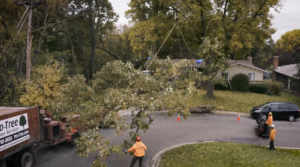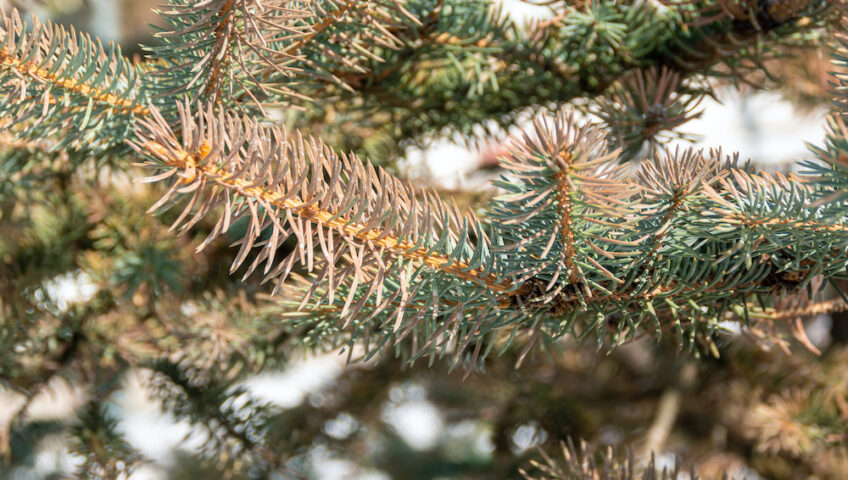Minnesota is a heavily forested state that is home to a diverse variety of trees, which are a big part of the state’s natural beauty. Unfortunately, trees are not as invulnerable as they appear. Several species of tree-boring insects and fungal diseases, many of them invasive in the United States, can kill trees from within.
 If you live on a property with trees, it’s important to be aware of these threats so that you can proactively protect your valuable trees. Continue reading to learn about three of the most serious tree threats in Minnesota and how to identify them.
If you live on a property with trees, it’s important to be aware of these threats so that you can proactively protect your valuable trees. Continue reading to learn about three of the most serious tree threats in Minnesota and how to identify them.
Dutch Elm Disease (DED)
Dutch elm disease is a disease caused by a fungus that is spread by elm bark beetles and through root grafts between elm trees. DED infects the vascular system of elm trees, causing wilting, yellowing of leaves, and ultimately tree death. Dutch elm disease first arrived in the United States in 1928 and was first identified in Minnesota in 1970. Since then, the disease has had a significant detrimental impact on elm populations in Minnesota.
One of the earliest symptoms of DED is wilting and yellowing of leaves on individual branches or sections of the tree canopy. Infected branches may exhibit “flagging” – a condition where leaves on affected branches wilt, curl, and turn brown while leaves on adjacent branches remain green. Dutch elm disease also causes discoloration of the sapwood beneath the bark, often appearing as gray or brown streaks or spots. As the disease progresses, entire sections of the tree canopy may die off, leading to a thinning appearance.
Emerald Ash Borer (EAB)
Emerald ash borers are invasive beetles native to Asia that have caused catastrophic damage to ash trees throughout North America, including here in Minnesota. EAB larvae feed on the inner bark of ash trees, disrupting the tree’s ability to transport water and nutrients and ultimately leading to tree death. Emerald ash borers were first discovered in Minnesota in 2009, and these tree-destroying pests have since spread throughout the state, killing millions of ash trees during the past fifteen years.
Ash trees infested with EAB typically exhibit canopy thinning and dieback starting from the top of the tree and progressing downward. Dead branches in the upper canopy can be an early sign of EAB infestation. In response to stress from emerald ash borer infestation, trees may spontaneously produce sprouts along their trunks and branches. Woodpeckers feed on EAB larvae, so you may notice them perching on infested ash trees and boring into the bark, revealing serpentine galleries created by the larvae feeding beneath.
Oak Wilt
Oak wilt is a fungal disease that primarily affects oak trees and is spread through both root grafts between trees and beetles that feed on tree sap. Oak wilt disrupts the flow of water and nutrients within the tree, leading to wilting, browning of leaves, and – if left untreated – the death of the tree. Oak wilt is prevalent in Minnesota, particularly in the eastern part of the state, including the Twin Cities. This disease poses a serious threat to oaks in both urban and forested areas.
In the early stages of oak wilt, leaves on infected trees may show symptoms such as wilting, curling, or browning along the outer edges. Leaves may also turn bronze or develop a pattern where the area between leaf veins turns yellow or brown. As the disease progresses, dark streaking in the sapwood beneath the bark may become visible. Trees infected with oak wilt may also exhibit thinning of the canopy. In some cases, the fungus may produce mats under the bark of infected trees. These mats often appear as raised, cracked areas of bark with a distinctive smell.
Trained Arborists Can Protect Your Trees From Threats
If you’re concerned about insects or diseases damaging your trees, your safest choice is to contact an arborist about how best to protect the trees on your property. Connect with Pro Tree today if you’d like to schedule a consultation with one of our arborists in the greater Twin Cities area!


Write a Comment